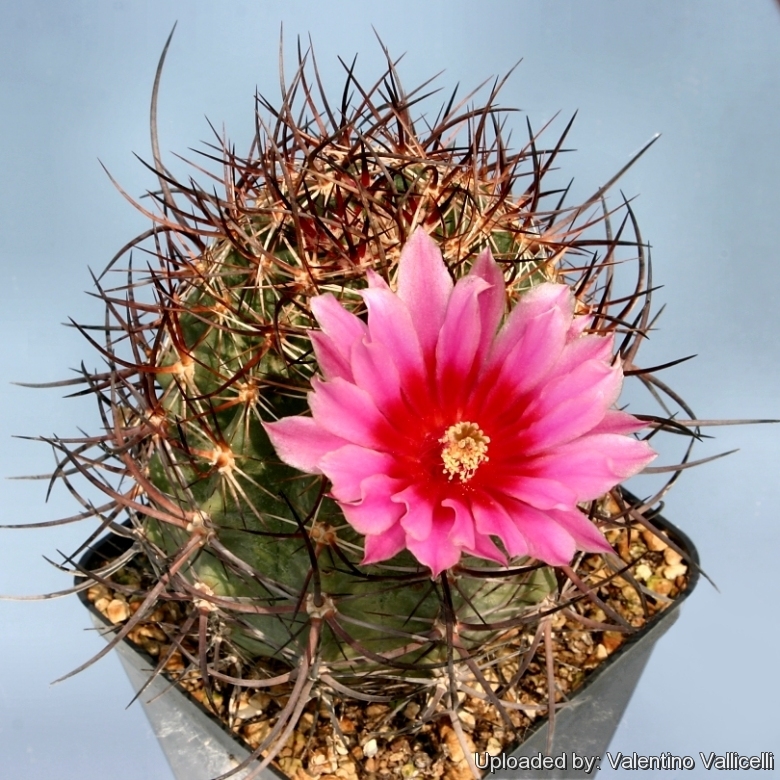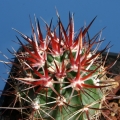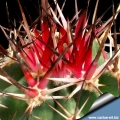
Echinocereus ferreirianus subs. lindsayi Photo by: Valentino Vallicelli
It was discovered in 1975 by Drs. Jorge Meyrán and George Lindsay and is one of the most interesting species with the genus Echinocereus for its attractively spination.
Origin and Habitat: Echinocereus ferreirianusSN|21825]]SN|21825]] comes from Eastern part of central Baja California and adjacent islands in the Gulf of California (Mexico, Northern America. Its two subspecies differ in range. subsp. ferreirianus is located in the eastern region of central Baja California and adjacent islands of Baja California while subsp. lindsayi is restricted to a region south of Cataviña in central Baja
Habitat and Ecology: Echinocereus ferreirianusSN|21825]]SN|21825]] grows on rocky mountains, low hills, slopes, and cliffs. It has been reported from shrub desert in pumice slopes, lava fields and in stony-loamy granite. The only threat is illegal collecting, in specific of the subspecies subsp. lindsayi.
Synonyms:
See all synonyms of Echinocereus ferreirianus
Common Names include:
SPANISH (Español): órgano pequeño de Jaraguay, Casa de Rata
Description: Echinocereus lindsayiSN|3382]]SN|3382]] is an heavily spined cactus with usually a solitary stem, but sometime it branches forming clumps with several stems. The spines are very robust and long almost obscuring the stem.
Stem: Up to 13 cm tall and 10 cm in diameter. Spherical to cylindrical, grey-green to green.
Central spines: Usually 4 (but sometime up to 7) strong, round in cross section, 1,5 to 10 cm long usually curved, bright red when young later dark grey to brown.
Radial spines: 8 to 14 shorter, spreading, whitish 0,8 to 4,5 cm long.
Flowers: 6-10 cm long, 4-9,5 cm broad, arising laterally near the apex, funnel-shaped, pink, bright purple to dark magenta with an orange to deep-red contrasting throat. Sigma green.
Blooming season: May.
Subspecies, varieties, forms and cultivars of plants belonging to the Echinocereus ferreirianus group
- Echinocereus ferreirianus H.E.Gates: has stems 30-40 cm high and about 8 cm in diameter, and almost always 4 central spines. Distribution: eastern part of central Baja California and adjacent islands in the Gulf of California.
 Echinocereus ferreirianus subs. lindsayi (J.Meyran) N.P.Taylor: has solitary stems less than 13 cm tall and 10 cm in diameter, and 4-7 stout central spines. Distribution: south of Catavina in central Baja California.
Echinocereus ferreirianus subs. lindsayi (J.Meyran) N.P.Taylor: has solitary stems less than 13 cm tall and 10 cm in diameter, and 4-7 stout central spines. Distribution: south of Catavina in central Baja California. Echinocereus ferreirianus subs. lindsayi f. monstruosus hort.: is a free offsetting mutant that forms large, proliferating stems, with white woolly areoles and short bristle-like spines. Flowers pink, often failing to open widely.
Echinocereus ferreirianus subs. lindsayi f. monstruosus hort.: is a free offsetting mutant that forms large, proliferating stems, with white woolly areoles and short bristle-like spines. Flowers pink, often failing to open widely.
Bibliography: Major references and further lectures
1) Edward Anderson “The Cactus family” Timber Press, Incorporated, 2001
2) Nathaniel Lord Britton, Joseph Nelson Rose “Cactaceae: Descriptions and Illustrations of Plants of the Cactus Family” vol. 4 The Carnegie Institution of Washington, Washington 1923
3) James Cullen, Sabina G. Knees, H. Suzanne Cubey "The European Garden Flora Flowering Plants: A Manual for the Identification of Plants Cultivated in Europe, Both Out-of-Doors and Under Glass" Cambridge University Press, 11/Aug/2011
4) David R Hunt; Nigel P Taylor; Graham Charles; International Cactaceae Systematics Group. "The New Cactus Lexicon" dh books, 2006
5) León de la Luz, J.L., Gómez-Hinostrosa, C. & Hernández, H.M. 2013. Echinocereus ferreirianus. In: IUCN 2013. "IUCN Red List of Threatened Species". Version 2013.2. <www.iucnredlist.org>. Downloaded on 30 March 2014.
 Echinocereus ferreirianus subs. lindsayi Photo by: Prof. Ilham Alakbarov
Echinocereus ferreirianus subs. lindsayi Photo by: Prof. Ilham Alakbarov Echinocereus ferreirianus subs. lindsayi Photo by: Cactus Art
Echinocereus ferreirianus subs. lindsayi Photo by: Cactus Art Echinocereus ferreirianus subs. lindsayi Photo by: Cactus Art
Echinocereus ferreirianus subs. lindsayi Photo by: Cactus Art Echinocereus ferreirianus subs. lindsayi Photo by: Cactus Art
Echinocereus ferreirianus subs. lindsayi Photo by: Cactus Art Echinocereus ferreirianus subs. lindsayi Photo by: Cactus Art
Echinocereus ferreirianus subs. lindsayi Photo by: Cactus Art Echinocereus ferreirianus subs. lindsayi Photo by: Cactus Art
Echinocereus ferreirianus subs. lindsayi Photo by: Cactus Art Echinocereus ferreirianus subs. lindsayi Photo by: Cactus Art
Echinocereus ferreirianus subs. lindsayi Photo by: Cactus Art Echinocereus ferreirianus subs. lindsayi Photo by: Valentino Vallicelli
Echinocereus ferreirianus subs. lindsayi Photo by: Valentino VallicelliCultivation and Propagation: This plant from Baja California needs warmer winter temperatures, and can resist only occasional light frost, above -2C. It is sensitive to overwatering (rot prone) and needs good drainage. Fertilize with half-strength liquid fertilizer in summer. Keep absolutely dry in winter. Needs full sun;
Propagation: Seeds or cutting (if available)
Your Photos

by Valentino Vallicelli

by Cactus Art

by Cactus Art





















